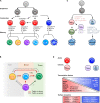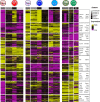The architectural design of CD8+ T cell responses in acute and chronic infection: Parallel structures with divergent fates
- PMID: 33755719
- PMCID: PMC7992501
- DOI: 10.1084/jem.20201730
The architectural design of CD8+ T cell responses in acute and chronic infection: Parallel structures with divergent fates
Abstract
In response to infection, T cells adopt a range of differentiation states, creating numerous heterogeneous subsets that exhibit different phenotypes, functions, and migration patterns. This T cell heterogeneity is a universal feature of T cell immunity, needed to effectively control pathogens in a context-dependent manner and generate long-lived immunity to those pathogens. Here, we review new insights into differentiation state dynamics and population heterogeneity of CD8+ T cells in acute and chronic viral infections and cancer and highlight the parallels and distinctions between acute and chronic antigen stimulation settings. We focus on transcriptional and epigenetic networks that modulate the plasticity and terminal differentiation of antigen-specific CD8+ T cells and generate functionally diverse T cell subsets with different roles to combat infection and cancer.
© 2021 Chung et al.
Conflict of interest statement
Disclosures: S.M. Kaech reported personal fees from Celsius Therapeutics and EvolveImmune outside the submitted work. No other disclosures were reported.
Figures



Similar articles
-
Heterogeneity and fate choice: T cell exhaustion in cancer and chronic infections.Curr Opin Immunol. 2019 Jun;58:98-103. doi: 10.1016/j.coi.2019.04.014. Epub 2019 Jun 8. Curr Opin Immunol. 2019. PMID: 31181510 Free PMC article. Review.
-
Heterogeneity and cell-fate decisions in effector and memory CD8+ T cell differentiation during viral infection.Immunity. 2007 Sep;27(3):393-405. doi: 10.1016/j.immuni.2007.08.007. Immunity. 2007. PMID: 17892848 Free PMC article. Review.
-
Virus-specific CD8 T cells: activation, differentiation and memory formation.APMIS. 2009 May;117(5-6):356-81. doi: 10.1111/j.1600-0463.2009.02459.x. APMIS. 2009. PMID: 19400862 Review.
-
CD8 T-cell memory differentiation during acute and chronic viral infections.Adv Exp Med Biol. 2010;684:79-95. doi: 10.1007/978-1-4419-6451-9_7. Adv Exp Med Biol. 2010. PMID: 20795542
-
Inflation vs. Exhaustion of Antiviral CD8+ T-Cell Populations in Persistent Infections: Two Sides of the Same Coin?Front Immunol. 2019 Mar 6;10:197. doi: 10.3389/fimmu.2019.00197. eCollection 2019. Front Immunol. 2019. PMID: 30894851 Free PMC article.
Cited by
-
The CD8+ T cell tolerance checkpoint triggers a distinct differentiation state defined by protein translation defects.Immunity. 2024 Jun 11;57(6):1324-1344.e8. doi: 10.1016/j.immuni.2024.04.026. Epub 2024 May 21. Immunity. 2024. PMID: 38776918 Free PMC article.
-
HDAC1 controls the generation and maintenance of effector-like CD8+ T cells during chronic viral infection.J Exp Med. 2025 Aug 4;222(8):e20240829. doi: 10.1084/jem.20240829. Epub 2025 Jun 4. J Exp Med. 2025. PMID: 40464916 Free PMC article.
-
Systems-level identification of key transcription factors in immune cell specification.PLoS Comput Biol. 2022 Sep 26;18(9):e1010116. doi: 10.1371/journal.pcbi.1010116. eCollection 2022 Sep. PLoS Comput Biol. 2022. PMID: 36156073 Free PMC article.
-
The Interplay of Transcription and Genome Topology Programs T Cell Development and Differentiation.J Immunol. 2022 Dec 15;209(12):2269-2278. doi: 10.4049/jimmunol.2200625. J Immunol. 2022. PMID: 36469845 Free PMC article.
-
Friend or Foe - Tc17 cell generation and current evidence for their importance in human disease.Discov Immunol. 2023 Jul 20;2(1):kyad010. doi: 10.1093/discim/kyad010. eCollection 2023. Discov Immunol. 2023. PMID: 38567057 Free PMC article. Review.
References
-
- Ahmadzadeh, M., Johnson L.A., Heemskerk B., Wunderlich J.R., Dudley M.E., White D.E., and Rosenberg S.A.. 2009. Tumor antigen-specific CD8 T cells infiltrating the tumor express high levels of PD-1 and are functionally impaired. Blood. 114:1537–1544. 10.1182/blood-2008-12-195792 - DOI - PMC - PubMed
Publication types
MeSH terms
Substances
Grants and funding
LinkOut - more resources
Full Text Sources
Other Literature Sources
Medical
Research Materials

